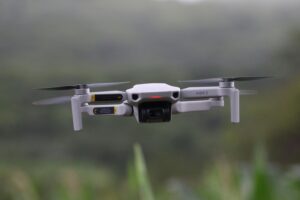NASA Autonomy Research Human Factors in Aviation

image public domain
Exploring the Future of Human-Aircraft Interaction with NASA Researcher Andy Lacher at AUVSI Xponential 2024
by DRONELIFE Contributing Editor Paul Rossi
Interview with Andy Lacher, NASA Researcher, at AUVSI Xponential 2024
As we stand at the brink of a transformative era in aviation, NASA is delving deeper into the symbiosis between humans and autonomous aircraft systems. At the forefront of this exploration is Andy Lacher, a NASA researcher heavily involved in autonomy and human factors research. I had the opportunity to sit down with Lacher at the AUVSI Xponential 2024. Our conversation revealed insightful perspectives on NASA’s current projects and the future role of human pilots in an increasingly automated aerospace sector.
Human-Machine Harmony
NASA’s commitment to understanding human interaction with aircraft systems stretches back to the early days of onboard systems and has evolved significantly with the advent of unmanned aircraft systems (UAS). When asked about how NASA is exploring the interaction between humans and these systems, Lacher highlighted the critical importance of human roles in the safety and operation of UAS, especially in beyond visual line of sight (BVLOS) scenarios. “Humans are a routine piece of safe operations,” Lacher explained. “While we often focus on incidents, understanding what happens when things go right is equally crucial for shaping future methods of human intervention.”
Managing the Skies
One of the major challenges in modern aviation is the management of multiple autonomous aircraft simultaneously. NASA is tackling this challenge head-on by collaborating with community and industry working groups. Lacher shared that the focus is on “developing methodologies to demonstrate safety and to classify when human intervention is necessary, along with understanding interactions with air traffic control (ATC).” This involves leveraging human factors expertise to comprehend how tasks can accumulate and how to maintain focus across several aircraft.
The Future of Piloting
With the rise of aircraft automation, the role of human pilots is undeniably changing. Lacher discussed this shift, particularly in terms of traditional flight operation roles such as the pilot in command (PIC), pilot flying, and pilot not flying. “We’re looking at having the duties of the pilot flying and pilot not flying managed by automation, with the human PIC remaining actively engaged in the operations,” he said. This reimagined role allows pilots to oversee more strategic aspects of flight management while relying on automation for routine tasks.
Key Takeaways for DroneLife.com Readers
For enthusiasts and professionals reading DroneLife.com, Lacher’s message is clear: aviation systems are inherently resistant to rapid change. “Aviation focuses on careful and proven changes that have been safely demonstrated,” he noted. Unlike the high-risk cultures of venture capital and startups, aviation demands a meticulous and conservative approach to innovation. However, Lacher assures us that the FAA is working hard, while focusing on safety, to facilitate the advancement of UAS technologies.
Read more:

 Paul Rossi is the Chief Operations Officer and Chief Pilot atNine Ten Drones, a N. C.-based drone services company, training center, and reseller. Rossi is also the Outreach Coordinator for the North Carolina Chapter of AUVSI. A graduate of Embry Riddle Aeronautical University and the U.S. Army Aviation Logistics School, Rossi is passionate about the aviation industry. He holds both a private pilot’s license for manned aircraft and a Part 107 Remote Pilot’s Certificate. You can see more videos and product information on the Nine Ten Drones YouTube channel.
Paul Rossi is the Chief Operations Officer and Chief Pilot atNine Ten Drones, a N. C.-based drone services company, training center, and reseller. Rossi is also the Outreach Coordinator for the North Carolina Chapter of AUVSI. A graduate of Embry Riddle Aeronautical University and the U.S. Army Aviation Logistics School, Rossi is passionate about the aviation industry. He holds both a private pilot’s license for manned aircraft and a Part 107 Remote Pilot’s Certificate. You can see more videos and product information on the Nine Ten Drones YouTube channel.
Miriam McNabb is the Editor-in-Chief of DRONELIFE and CEO of JobForDrones, a professional drone services marketplace, and a fascinated observer of the emerging drone industry and the regulatory environment for drones. Miriam has penned over 3,000 articles focused on the commercial drone space and is an international speaker and recognized figure in the industry. Miriam has a degree from the University of Chicago and over 20 years of experience in high tech sales and marketing for new technologies.
For drone industry consulting or writing, Email Miriam.
TWITTER:@spaldingbarker
Subscribe to DroneLife here.

